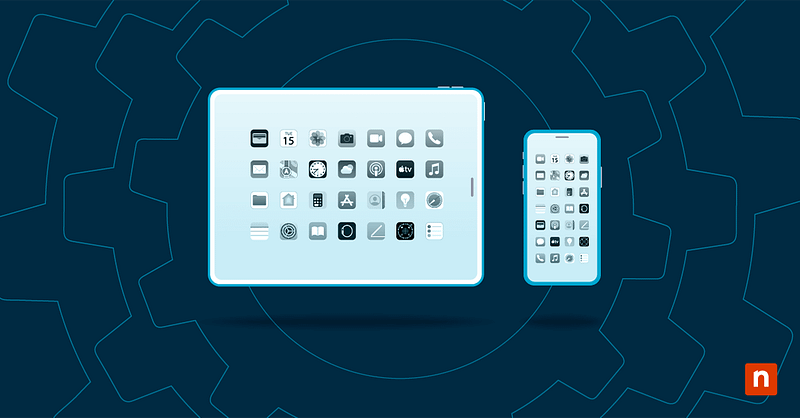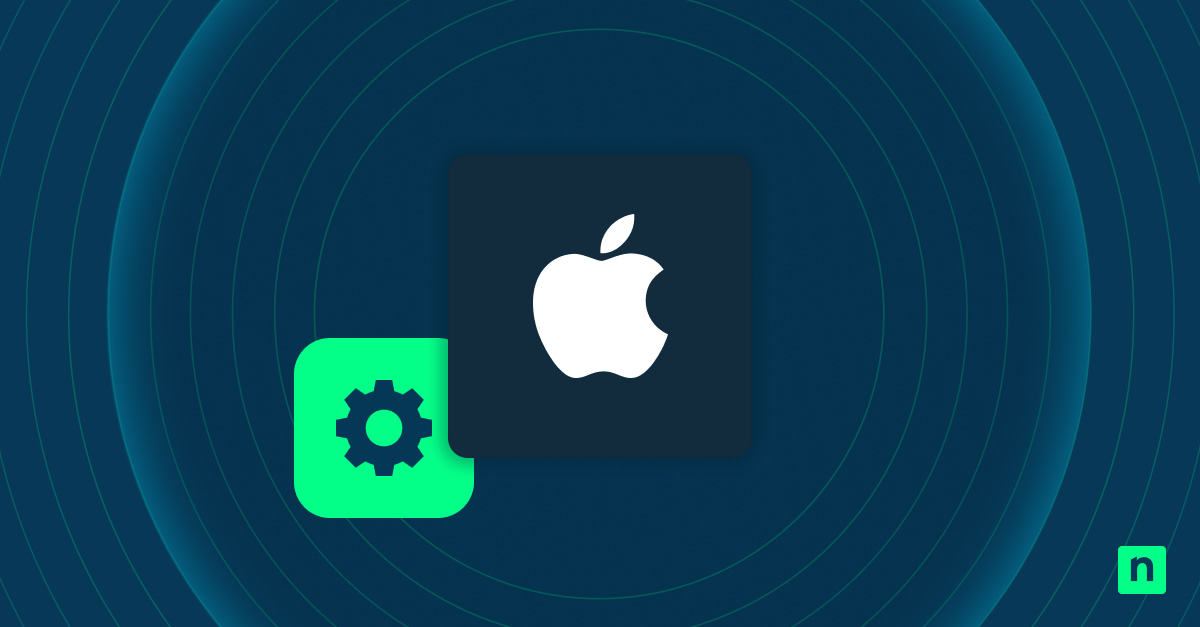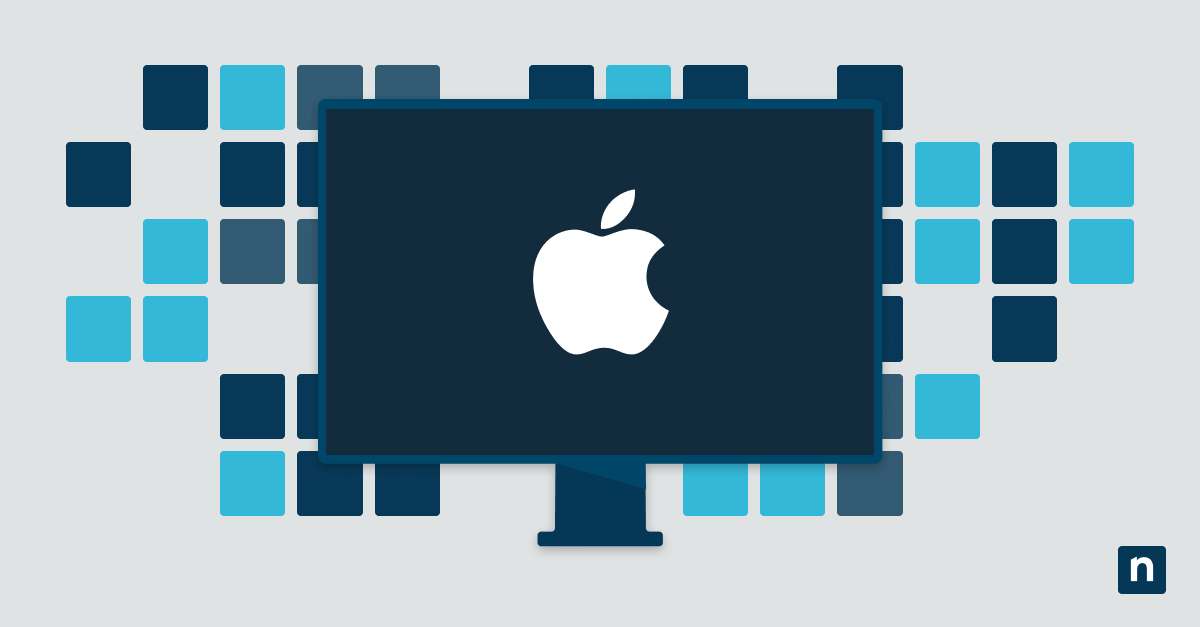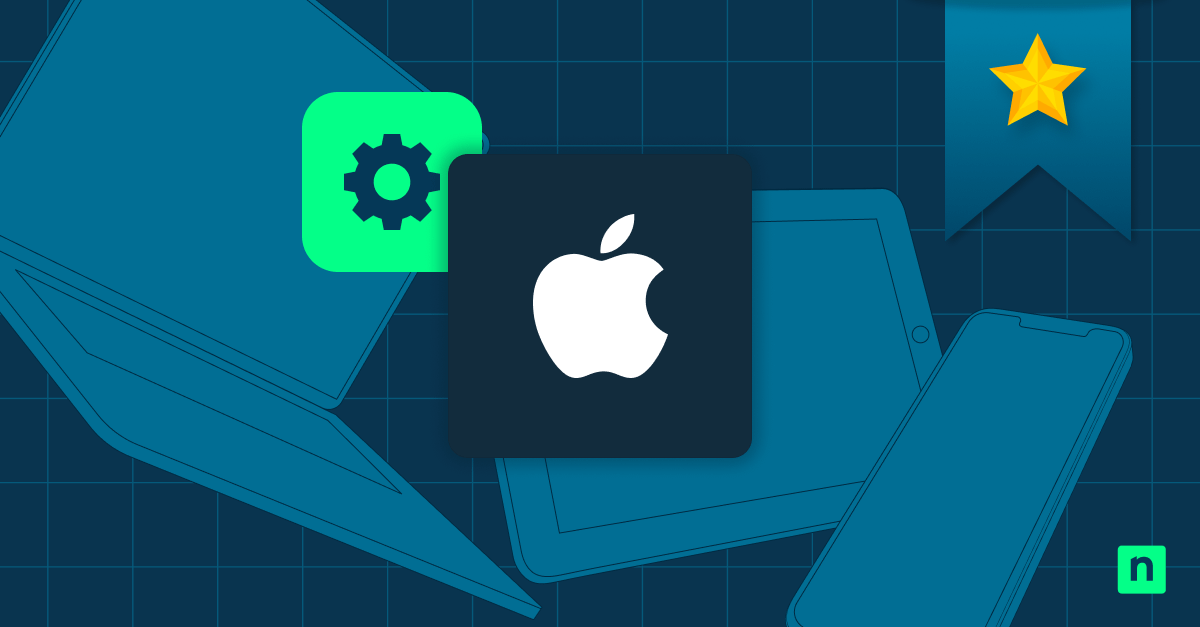Key Points:
- What Is Apple Business Manager (ABM)? ABM is a free web-based Apple platform that enables centralized deployment, configuration, and administration of iPhones, iPads, Macs, and Apple TVs across businesses and educational institutions.
- ABM Is Not MDM But Complements It: ABM works alongside mobile device management (MDM) software by automating device enrollment and setup while MDM enforces policies, security, and ongoing management.
- Automated Device Enrollment (ADE): ABM supports zero-touch deployment via ADE, ensuring devices are automatically enrolled in MDM and supervised straight out of the box.
- Apple School Manager (ASM) vs. ABM: ASM offers the same core features as ABM with added functionality for education, such as student information system (SIS) integration and class-based user grouping.
- ABM + MDM Lifecycle Management: ABM handles provisioning and ownership; MDM handles ongoing management, monitoring, and compliance enforcement.
- Tips to Keep ABM and MDM in Sync: Immediately assign new devices to MDM, use smart groups or tags in your MDM, and regularly audit enrollment status for compliance gaps.
This guide answer the question What is Apple Business Manager (ABM)” as well as explains how ABM device management, and how its features benefits businesses and organizations by helping them deploy, secure, and manage their employees phone, tablets, and laptops.
What is Apple Business Manager (ABM)?
Apple Business Manager (ABM) is a free web-based tool for centrally managing Apple devices, including iPads, iPhones, Macs, and Apple TVs. In conjunction with mobile device management (MDM) solutions, is used by businesses and educational institutions to deploy, oversee, and administer employee devices. As such, ABM and MDM are vital to the efficiency and security of IT operations at any company that deploys Apple devices.
Experience full control and visibility of your Apple endpoint devices.
Who benefits from Apple Business Manager?
Apple Business Manager is ideal for any organization that needs to deploy, manage, and secure multiple Apple devices efficiently. While it’s widely used across industries, certain environments gain exceptional value from its automation, security, and centralized control.
- Enterprises with large Apple deployments: Enterprises managing large fleets of Macs, iPhones, and iPads benefit from ABM’s zero-touch deployment and Automated Device Enrollment (ADE).
- Educational institutions using Apple School Manager (ASM): Schools and universities use ASM, a variant of ABM, to manage student and teacher devices.
- Remote-first and hybrid companies: Organizations with distributed teams can use ABM to ship devices directly to employees, fully pre-configured and enrolled in MDM.
- Managed service providers (MSPs) and IT consultants: MSPs use ABM to manage devices for multiple clients from a single interface. They can assign devices to different MDM servers, automate enrollment, push apps, and enforce policies across organizations.
- Small businesses with growing Apple footprints: Even smaller teams benefit from ABM’s ability to enforce MDM enrollment, control Apple IDs, and distribute work apps.
What is ABM device management?
Apple Business Manager device management lets you manage the deployment of your entire fleet of Apple devices from a web interface. It lets you supervise the devices, the Apple IDs used to sign in to them, and the content on them.
How ABM device management works
Using Apple Business Manager, administrators can customize the Setup Assistant process for users, including implementing authentication and modifying the text and branding shown when a device is first set up by the user. Devices deployed using ABM can be supervised, ensuring strict control of the device.
Organization-specific Apple IDs can be created and centrally managed in ABM, removing the need for employees to use their personal Apple IDs to sign in to devices (or creating separate work Apple IDs themselves, of which you’d have no control), ensuring that you have ownership and oversight over the user accounts used to sign into company devices.
Devices can also be automatically enrolled in MDM, greatly saving time and resources over manually setting up each employee device.
In addition, content can be deployed using ABM: apps and books – as well as apps your organization has developed for internal use – can be purchased and deployed in bulk. Licenses for content can be purchased and assigned (or reassigned), and content can be distributed or disabled per device or per user.
In summary, Apple Business Manager allows IT admins to
- automate MDM enrollment during device setup,
- assign and manage managed Apple IDs,
- customize the Setup Assistant workflow,
- control supervision settings,
- distribute apps and books purchased through Apps and Books.
ABM and MDM are important tools for organizations that have to manage multiple devices and want to ensure that they’re secure and only being used for their intended business purposes. Once ABM has been used to deploy a device with MDM, you can enforce device encryption and remotely wipe devices (which is especially important as Apple devices are often a target for theft).
What is the difference between Apple Business Manager and Apple School Manager?
Apple School Manager functions the same way as Apple Business Manager, with some additional education-centric features such as support for student information systems (SIS) and grouping user accounts in classes with teacher and student roles. Like ABM,
- enables zero-touch device management,
- integrates with MDM solutions, and
- supports management of Apple IDs, apps, and content.
However, ASM is specifically designed for K-12 and higher education institutions.
How to set up Apple Business Manager and Automated Device Enrollment
After you sign up for Apple Business Manager and verify your account enrollment, you can start adding devices. This can be done using the Apple Configurator for your existing devices or devices not purchased directly from Apple through your business account.
To further simplify device management, you can set up ADE so that your devices are attached to your account, straight out of the box. This removes the need for manually setting up devices and instead you can ship them straight out to users; all they need to do is sign in using your customized Setup Assistant workflow.
Furthermore, you can add your sales information so that newly purchased devices from Apple or approved resellers will be added to your account as soon as they’re activated. During this process you can also add your MDM server, allowing devices to be assigned to it (and ensuring that MDM enrollment can’t be skipped or removed).
Apple Business Manager features and functionalities
These are the main features of Apple Business Manager that you can leverage to employ optimal ABM device in your organization:
- Manual and automated device enrollment: You can choose to enroll your devices manually using the Apple Configurator or so that your devices are enrolled and managed as soon as they come online. You can even customize the setup experience with your own text, branding, and authentication.
- Over-the-Air (OTA) configuration: Deploy configurations to multiple devices remotely, removing the need to manually connect and update them. Enable supervision and set MDM servers based on the type of device.
- App and book management and user/device assignment: Assign licenses based on user/device for work-related apps, and distribute them wirelessly. This removes the need to manually connecting devices to install apps using Apple Configurator.
- Apps and Books: Take advantage of ABM’s Apps and Books to streamline the bulk purchase of apps and content.
- Managed Apple IDs for employees and students: Centrally manage the Apple IDs your employees or students will use to log in to devices. Access data stored in iCloud, and optionally connect with Microsoft Entra ID for integration with corporate networks. However, note that you can federate managed Apple IDs with Entra ID for sign-in only, not full identity lifecycle management, as ABM doesn’t sync groups or permissions from Entra ID.
- MDM integration: Integrate ABM with your MDM solution for additional functionality, including monitoring, security, device policies, and other advanced configuration and management options.
How Apple Business Manager works with Mobile Device Management
Apple Business Manager is not an MDM system and can not replace one. Both play different roles:
- ABM facilitates enrollment in MDM (including assigning devices to specific MDM servers), ensures that all devices are configured out of the box, and manages the content and users on devices.
- MDM takes over from that point, providing additional features (depending on the MDM product) such as remote monitoring and enterprise device management, security and compliance monitoring, and other ongoing management tasks.
A summary of ABM vs MDM
Feature | ABM | MDM |
| Purpose | Automates device provisioning and links devices to your organization | Manages devices after enrollment with policies, settings, and security enforcement |
| Device enrollment | Enables zero-touch enrollment via ADE; devices are pre-assigned to MDM during activation | While you can enroll an Apple device in an MDM solution without ABM, it may be slightly more difficult. You would need to have physical access to the device, cannot reassign it remotely, and would lack zero-touch deployment. |
| Supervision setup | Enables automatic OTA supervision during setup with ADE | Can supervise devices manually via Apple Configurator (however, this requires physical access and is reversible) |
| Apple ID management | Supports creation and management of managed Apple IDs for corporate/work use | Enforces restrictions and access settings on Apple IDs managed via ABM |
| Security and compliance | Ties devices to the organization for post-reset control; essential for loss/theft protection and secure provisioning | Enforces encryption, password policies, remote wipe, and monitoring for compliance and security posture |
Benefits of Apple Business Manager for enterprise device management
Enterprise device management can be a complex process — from the initial setup of devices, user creation and management to managing the apps and content they require to fulfill their work duties, each additional employee and device can add significant workload to IT teams. Apple Business Manager streamlines the deployment of devices and the management of the associated Apple IDs and apps, while MDM extends this into full remote device monitoring and management from a central interface.
IT departments that are unburdened by these initial unboxing and configuration tasks and can leverage automation in MDM platforms to keep devices up-to-date and secure are more efficient and have more time to implement infrastructure improvements and focus on real user problems.
To gain a clearer image of how ABM, in tandem with MDM, can benefit enterprise device management, let’s look at this simple lifecycle management table:
Phase | ABM’s role | MDM’s role |
| Procurement | Automatically registers devices to the organization | N/A |
| Deployment | Assigns to MDM and enforces the setup flow | Applies initial policies |
| Daily Use | N/A | Pushes updates, security settings, and compliance |
| Offboarding | Maintains ownership | Remotely wipe device and revokes access to it. |
💡 Tip: How to keep Apple Business Manager and MDM in sync
A common mistake many organizations commit when using Apple Business Manager is failing to properly assign or monitor devices after they’ve been added to their ABM portal. While devices may show up automatically after purchase – additionally, this may take up to 24 hours – they won’t be enrolled in MDM until they’re explicitly assigned to an MDM server. Without this step, zero-touch provisioning won’t work, and users may be able to bypass device supervision.
Here’s how to keep ABM and MDM tightly aligned:
- Assign devices to an MDM server immediately after they appear in ABM. Don’t leave them unassigned.
- Use tags, smart groups, or organizational units in your MDM to group devices by role, department, or geography for more efficient policy enforcement.
- Regularly audit device enrollment status to catch issues like devices that weren’t properly assigned, activated before enrollment, or removed from supervision unintentionally.
Keeping your ABM-to-MDM handoff clean ensures consistent enforcement of security policies, seamless user experiences, and compliance with your organization’s provisioning strategy.
Apple Business Manager challenges and considerations for MDM
Apple Business Manager and MDM solve many of the headaches of managing multiple devices but can be frustrating if not used correctly. You should
- ensure that you have sufficient licenses available for your MDM solution before adding new devices,
- keep track of managed Apple IDs and volume licenses so that you aren’t assigning app licenses to users who do not need them, and
- make sure that your devices are supported and that your organization meets the requirements for ADE if you plan on using it.
While ABM doesn’t require that you connect it with an MDM server, attempting to manage a fleet of Apple devices without it can be a complex manual task. Apple Configurator (2 for macOS and Configurator for iPhone) can enroll devices into ABM retroactively, but it’s only available for certain devices and requires manual setup via USB or network proximity. This is far from ideal for organizations with more than a few devices.
Choosing an MDM for Apple Business Manager
Finally, there are top features you should consider when evaluating MDM platforms to realize the full benefits of Apple Business Manager.
- ADE support to enable zero-touch provisioning and persistent supervision.
- real-time monitoring and alerting so IT can proactively respond to compliance or security issues.
- robust app distribution and patch management to automate the deployment of both App Store and custom enterprise apps.
- support for managed Apple IDs, allowing integration with ABM for user-based app assignments and identity management.
- scalability and multi-site management to accommodate growth, remote workforces, or multi-client environments (especially important for MSPs).
For a more thorough discussion on these features, we recommend reading these articles:
In summary
When choosing an MDM platform to pair with Apple Business Manager or Apple School Manager, you should first make sure that it’s compatible and that it supports the functionality you require.
NinjaOne’s Apple MDM solution supports ABM and ADE, and it simplifies deployment, management, and app distribution for Apple devices while providing robust enterprise device management features such as monitoring and security controls to support growing businesses.
Enhance iOS and macOS device security. Watch how Apple Business Manager (ABM) impacts device management.
Access Apple Business Manager and other MDM tools from a single dashboard.
Choosing a mobile device management solution for Apple Business Manager
When choosing a mobile device management platform to pair with Apple Business Manager or Apple School Manager, you should first make sure that it is compatible and that it supports the functionality you require.
NinjaOne’s Apple MDM solution supports Apple Business Manager and Automated Device Enrollment and simplifies the deployment, management, and app distribution for Apple devices while providing robust enterprise device management features such as monitoring and security controls to support growing businesses.








